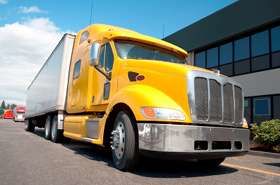What Would You Do????
Topic 13322 | Page 1
Well I'm not sure I would try 650 miles of California and Oregon in that tight window. For planning, that's 50mph country. That means 13 hours of driving. I don't like my guardian angel to work that hard. But, the rest of the puzzle looks like the split sleeper berth rule.
Sleeper Berth:
The portion of the tractor behind the seats which acts as the "living space" for the driver. It generally contains a bed (or bunk beds), cabinets, lights, temperature control knobs, and 12 volt plugs for power.
I understand your story saying the original payload was 44500, truck weight 83400. After the first scale you went back, they took 10140 off (44500 - 34360) and you were still overweight? You only needed to lose at least 3400 lbs. How does that work?

I think he's saying the tandems were over with them back as far as allowed. Anyway, I've only been at this a few weeks and I stay in the northeast, but here I've never seen a weigh station open except during the day, so you could probably drive until 0500,, then start up again in the afternoon and miss them. Otherwise it seems like you'd have no choice but to tell them you can't be back until 1000 or so.
Tandems:
Tandem Axles
A set of axles spaced close together, legally defined as more than 40 and less than 96 inches apart by the USDOT. Drivers tend to refer to the tandem axles on their trailer as just "tandems". You might hear a driver say, "I'm 400 pounds overweight on my tandems", referring to his trailer tandems, not his tractor tandems. Tractor tandems are generally just referred to as "drives" which is short for "drive axles".
Tandem:
Tandem Axles
A set of axles spaced close together, legally defined as more than 40 and less than 96 inches apart by the USDOT. Drivers tend to refer to the tandem axles on their trailer as just "tandems". You might hear a driver say, "I'm 400 pounds overweight on my tandems", referring to his trailer tandems, not his tractor tandems. Tractor tandems are generally just referred to as "drives" which is short for "drive axles".

...oh, or you could slide them back a couple holes and hope no one counts.
I understand your story saying the original payload was 44500, truck weight 83400. After the first scale you went back, they took 10140 off (44500 - 34360) and you were still overweight? You only needed to lose at least 3400 lbs. How does that work?
I think he's saying that after the first rework he was still at 34360 on the trailer. In California 40ft is the maximum length so he couldn't shift any more.
...oh, or you could slide them back a couple holes and hope no one counts.
I recently made this mistake. My weights were OK but I forgot to check the length first. I should have waited a day to rework it. Instead I lost a nights sleep worrying about it, delivered the load as is and got real lucky. Never again. Drivers shouldn't take risks we don't have to. I think I actually heard the veterans from this forum that night of sleeplessness.

...oh, or you could slide them back a couple holes and hope no one counts.
I recently made this mistake. My weights were OK but I forgot to check the length first. I should have waited a day to rework it. Instead I lost a nights sleep worrying about it, delivered the load as is and got real lucky. Never again. Drivers shouldn't take risks we don't have to. I think I actually heard the veterans from this forum that night of sleeplessness.
Yeah, I guess the question is "what would you do" and not, what could he have done. I would probably tell them I can't come back until after a 10 hour break, unless there was some important reason to take a risk.
...oh, or you could slide them back a couple holes and hope no one counts.
I recently made this mistake. My weights were OK but I forgot to check the length first. I should have waited a day to rework it. Instead I lost a nights sleep worrying about it, delivered the load as is and got real lucky. Never again. Drivers shouldn't take risks we don't have to. I think I actually heard the veterans from this forum that night of sleeplessness.
Yeah, I guess the question is "what would you do" and not, what could he have done. I would probably tell them I can't come back until after a 10 hour break, unless there was some important reason to take a risk.
That's a good point. We often forget that of all the factors of on time delivery, the driver has some needs to. HOS is our idea, it's law.
HOS:
Hours Of Service
HOS refers to the logbook hours of service regulations.
Sorry yes the tamdoms were at 34360 and I could not take any more weight off them because I was at 40 feet so I went back. I don't take chances with that in ca there is one scale on my route that is always open and always pull me in.
So here is that I did I went out to the street and shut down with my trailer. I chose to keep the trailer with me for 2 reasons 1 there was no one to sign for it and keep an eye on it, and I am resposible for the load sense I signed it. Second reason I held onto it is because I did not want them to get to it when ever is convenient. If your there with the load they are more likely to handle it right a way.
I parked on the street right across from the plant because I knew I could roll back in with out triggering my clock, I used the first part of an 8/2 split. I got 8.50 min back on my drive and about 11 on my 14. So I drive out my 8 hours with out stopping for a 30 min I shut down and took my 10 hour and then delivers the load.
The reason I chose to take a 10 hour and not do my 30min or my 2 hours is it did not get me anything worth will back. It would have added 2.30min to the time on this load. So I just rolled every thing into my 10 hour brake. As Rob said it planned takes 13 hours to make the run so I only had a little over 5 hours to drive this morning. This got the load in a little over 3 hours early my new appointment time was 1000 so a happy receiver. Makes for a happy dm and gets me down the road to my next stop 3 hour early so I can take a full 10 and load here tonight. If you ever need to make up time on a load you can do that my eliminating a brake to shave time off the load. Just a little something that you can add to your bag, to help you out.
This is how I handled it dose not mean it was the only way to do it. Just one way to do it.
Dm:
Dispatcher, Fleet Manager, Driver Manager
The primary person a driver communicates with at his/her company. A dispatcher can play many roles, depending on the company's structure. Dispatchers may assign freight, file requests for home time, relay messages between the driver and management, inform customer service of any delays, change appointment times, and report information to the load planners.HOS:
Hours Of Service
HOS refers to the logbook hours of service regulations.New Reply:
New! Check out our help videos for a better understanding of our forum features

















Preview:








 TT On Facebook
TT On Facebook
Alright new truck drivers and people thinking about doing this. Put on those thinking caps. Alright here is your load pick up 3/4 at 1700 hours in stockton ca, deliver to Troutdale or at 3/5 1700 hours. Miles 654. So I start this load at 1500 with pretip and then drive the hour to she shipper check in at 1615 to get my preloaded trailer and what do you know it's ready on time. Rolling out the gate at 1700 head off to get scaled should be no problem it's 44500. Get to my scale after sitting in traffic for an hour. Scale the load in at 83400 pounds back into traffic and back to stockton I go. to get the load reworked, 1 more hour in traffic people out here can not drive in the rain crashes every were. Gate time in is 1915. Get the trailer docked and jump into sleeper birth. 2.5 hours later Pounding on door I am done, out at 2200 hours back to scale. 2230 still can't scale legal, 34360 on the trailer and I am set at 40 feet. Back to the plant. Get there at 2300 Get told there is no one to rework the load. And get a 0600 hour appointment for a rework but I can not sleep on site. The shipper says I can drop the trailer on site and bobtail some place. The closest truck stop is about 9 miles a ways. Or I can go park on a street somewear. So remember my clock started at 1500 so I am dead at 0500. But I have 0600 appointment. So what would you guys do and why. I will tell you what I did and why I did it that way tomorrow. Also this is the load that gets me to the load that is getting me home a few days always works this way.
Bobtail:
"Bobtailing" means you are driving a tractor without a trailer attached.
Shipper:
The customer who is shipping the freight. This is where the driver will pick up a load and then deliver it to the receiver or consignee.
HOS:
Hours Of Service
HOS refers to the logbook hours of service regulations.